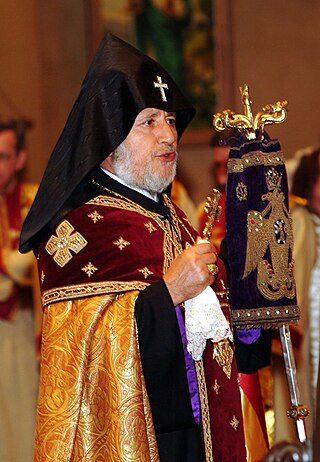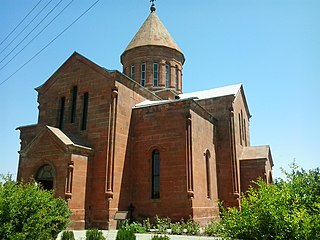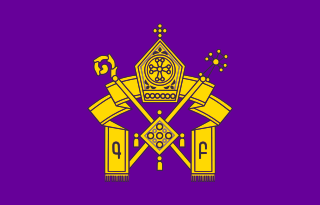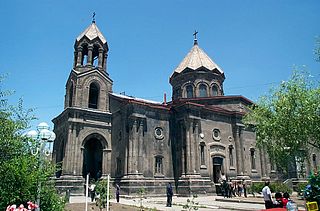
The Catholicos of All Armenians is the chief bishop and spiritual leader of Armenia's national church, the Armenian Apostolic Church, and the worldwide Armenian diaspora. The Armenian Catholicos is also known as the Armenian Pontiff and by other titles. According to tradition, the apostles Saint Thaddeus and Saint Bartholomew brought Christianity to Armenia in the first century. Saint Gregory the Illuminator became the first Catholicos of All Armenians following the nation's adoption of Christianity as its official religion in 301 AD. The seat of the Catholicos, and the spiritual and administrative headquarters of the Armenian Church, is the Mother See of Holy Etchmiadzin, located in the city of Vagharshapat.

The Armenian Apostolic Church is the national church of Armenia. Part of Oriental Orthodoxy, it is one of the most ancient Christian institutions. The Kingdom of Armenia was the first state in history to adopt Christianity as its official religion under the rule of King Tiridates III, of the Arsacid dynasty in the early 4th century.
A catholicos is the head of certain churches in some Eastern Christian traditions. The title implies autocephaly and, in some cases, it is the title of the head of an autonomous church. The word comes from ancient Greek καθολικός, derived from καθ' ὅλου from κατά and ὅλος, meaning "concerning the whole, universal, general"; it originally designated a financial or civil office in the Roman Empire.
The title of patriarchs of the East is used by primates of several Christian denominations within Eastern Christianity. Historically, the title originated as ecclesiastical designation for primates of the Church of the East. It was, and still is, officially used by different branches of the historical Church of the East.

Catholicos Garegin II is the Catholicos of All Armenians, the supreme head of the Armenian Apostolic Church, since 1999. In 2013 he was unanimously elected the Oriental Orthodox head of the World Council of Churches for the next eight years.
The Armenian Catholicosate of the Great House of Cilicia is an autocephalous Oriental Orthodox church. Since 1930, the Catholicosate of the Great House of Cilicia has been headquartered in Antelias, Lebanon. Aram I is the Catholicos of Cilicia since 1995.

Catholicos Karapet II Oolnetzi was the Catholicos of the Armenian Apostolic Church between 1726 and 1729.

Bambakashat ; is a village in the Armavir Province of Armenia.

Vagharshapat is the 5th-largest city in Armenia and the most populous municipal community of Armavir Province, located about 18 km (11 mi) west of the capital Yerevan, and 10 km (6 mi) north of the closed Turkish-Armenian border. It is commonly known as Ejmiatsin, which was its official name between 1945 and 1995. It is still commonly used colloquially and in official bureaucracy, a case of dual naming.

Saint Sarkis Cathedral is an Armenian cathedral in Yerevan, Armenia. It is the seat of the Araratian Pontifical Diocese of the Armenian Apostolic Church. It was built in 1842, on the left bank of the Hrazdan River in Yerevan's Kentron District.

The Saint Gregory the Illuminator Cathedral, also known as the Yerevan Cathedral is the largest cathedral of the Armenian Apostolic Church. It is located in the Kentron District of Yerevan, the capital of Armenia, and is one of the largest religious buildings in the South Caucasus along with the Holy Trinity Cathedral of Tbilisi. Adjacent to the General Andranik metro station, it is visible from many areas of Yerevan.

The Forty Martyrs Armenian Cathedral of Aleppo, Syria, is a 15th-century Armenian Apostolic church located in the old Christian quarter of Jdeydeh. It is significant among the Armenian churches for being one of the oldest active churches in the Armenian diaspora and the city of Aleppo. It is a three-nave basilica church with no dome. Its bell tower of 1912, is considered to be one of the unique samples of the baroque architecture in Aleppo.

Holy Mother of God Cathedral of Avan is a ruined 6th-century church located in the Avan District of Yerevan, the capital of Armenia. It is the oldest surviving church inside Yerevan's city limits.
Catholicos Ananias I, also known as Anania Mokatsi, was the Catholicos of the Armenian Apostolic Church between 949 and 968.
Basil of Ani or Basil Pahlavuni was Armenian Catholicos of Cilicia from 1105 to 1113. He was a member of the Pahlavuni noble house and a nephew of Catholicos Gregory II. In 1070, Gregory II made him bishop of Ani with the responsibilities of a vicar of the catholicos. In 1081, with Gregory's agreement, Catholicos Stepanos of Albania officially consecrated Basil as coadjutor of the Catholicos of Armenia at Haghpat Monastery. At this time, the Armenian Church was effectively divided between four leaders: Gregory II, Theodorus in Honi, Basil in Ani and Paul in Marash. In 1090, Basil visited the Seljuk sultan Malik-Shah I, who eased the Armenians' tax burden and recognized the supremacy of the Catholicosate of Ani, after which Basil deposed the catholicos based in Honi in Cilicia. After becoming catholicos in 1105, he took up his seat at Karmir Vank in Tsamndav. Almost is nothing is known about his patriarchate. He is said to have effectively governed the church and maintained its unity despite the chaotic times and the dispersion of the Armenian people. He died during a pilgrimage to Jerusalem in 1113 and was buried at Karmir Vank. He was succeeded by his relative Gregory III Pahlavuni as catholicos.

The Diocese of Gougark, is a diocese of the Armenian Apostolic Church encompassing the northern Lori Province of Armenia. It is named after the historic province of Gugark; the 13th province of the Kingdom of Armenia. The modern-day province of Lori was one of the cantons of historic Gugark. The diocesan headquarters are located in the city of Vanadzor. The seat of the bishop is the Saint Gregory of Narek Cathedral. Until December 2010, the churches of Tavush Province were under the jurisdiction of the Diocese of Gougark, when the new Diocese of Tavush was founded by Catholicos Karekin II.

Mother See of Holy Etchmiadzin, known in Armenian as simply the Mother See, is the governing body of the Armenian Apostolic Church. It is headquartered around Etchmiadzin Cathedral in Vagharshapat (Etchmiadzin), Armenia and is the seat of the Catholicos of All Armenians, the head of the church.

Church of the Holy Mother of God, is a church located in the town of Vagharshapat, Armenia. It was built in 1767, during the reign of Catholicos Simeon I of Yerevan, on the remains of a 16th-century wooden church. It is located at the center of modern-day Vagharshapat, around 200 meters north of the walls of the Mother See of Holy Etchmiadzin.

Diocese of Shirak, is one of the dioceses of the Armenian Apostolic Church covering the northern, central and south-western parts of the Shirak Province of Armenia. It almost covers 4/5th of the province, as the south-eastern town of Artik and its surrounding villages are excluded.

Saint Mesrop Mashtots Church is an Armenian Apostolic church in Oshakan that contains the grave of Mesrop Mashtots, the inventor of the Armenian alphabet. It is one of Armenia's better known churches and a pilgrimage site. Pilgrims visit the church on the Feast of the Holy Translators in October.












